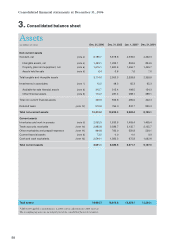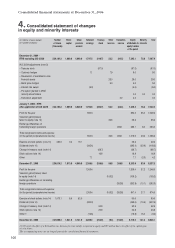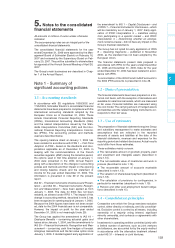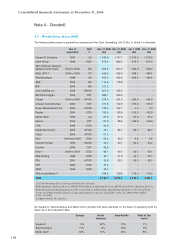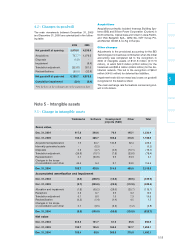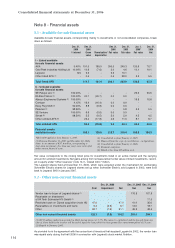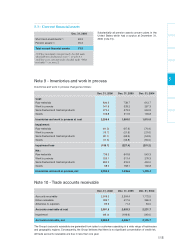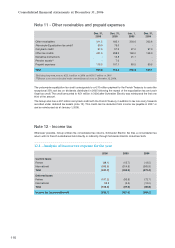APC 2006 Annual Report Download - page 108
Download and view the complete annual report
Please find page 108 of the 2006 APC annual report below. You can navigate through the pages in the report by either clicking on the pages listed below, or by using the keyword search tool below to find specific information within the annual report.
Consolidated financial statements at December 31, 2006
Interest rate swaps
Interest rate swaps, which synthetically adjust interest
rates on certain indebtedness, involve the exchange of
fixed and floating-rate interest payments. The differen-
tial to be paid (or received) is accrued (or deferred) as
an adjustment to interest income or expense over the
life of the agreement. The Group does not apply hedge
accounting as described in IAS 39 for interest rate
swaps. The impact is immediately recognized in the
income statement.
Commodity contracts
The Group also enters into raw material forward pur-
chase contracts. Moreover the Group enters into con-
tracts including swaps and options to hedge price risks
on all or part of its forecast future purchases. Under
IAS 39, these qualify as cash flow hedges. The hedg-
ing instruments are recognized in the balance sheet
and are measured at fair value at the period-end. The
portion of the gain or loss on the hedging instrument
that is determined to be an effective hedge is accumu-
lated in equity, under other reserves, and reclassified
into the income statement under cost of sales when
the hedged transaction affects profit or loss, leading to
an adjustment of gross profit. The ineffective portion of
the gain or loss on the hedging instrument is immedi-
ately recognized in other financial income and
expense.
Cash flows from derivative financial instruments are
recognized in the statement of cash flows in a manner
consistent with the underlying transactions.
Asset-backed securities issued by the
Special Purpose Entity holding perpetual
bonds
In accordance with SIC 12 –
Special Purpose Entities
– and IAS 39, the special purpose entity that holds the
perpetual bonds issued by the Group in 1991 was con-
solidated at December 31, 2005.
The swaps taken out by the special purpose entity in
connection with the perpetual bonds have been meas-
ured at fair value.
Interest rate swaps on the perpetual bonds taken out
directly by the Group are classified as derivative instru-
ments that do not qualify for hedge accounting. They
are therefore measured at fair value and gains and
losses arising from remeasurement at fair value are
recorded in other financial income and expense.
On December 15, 2006, the Group bought back the
perpetual bonds issued in 1991 from the special pur-
pose entity. As a result, the special purpose entity was
no longer consolidated at December 31, 2006.
Put options granted to minority
shareholders
Under IAS 32 –
Financial Instruments: Disclosure and
Presentation,
commitments to buy out minority share-
holders (e.g. put options) must be recognized in debt,
in an amount corresponding to the purchase price of
the minority interest.
In the absence of established accounting practice, the
difference between the purchase price of the minority
interests and the share in the acquired net assets has
been posted to goodwill without remeasuring the
acquired assets and liabilities. Subsequent changes in
the fair value of the debt will be recognized by adjust-
ing goodwill.
1.22 - Revenue recognition
The Group’s revenues primarily include merchandise
sales and revenues from service and project contracts.
Merchandise sales
Revenue from sales is recognized when the product is
shipped and title transferred (standard shipping terms
are FOB).
Rebates offered to the distributors are accrued as a
deduction from revenue when the products are sold to
the distributor.
Certain subsidiaries also offer cash discounts to dis-
tributors. These discounts are deducted from sales.
Total sales are presented net of these discounts and
rebates.
Service contracts
Revenue from service contracts is recorded over the
contractual period of service. It is recognized when the
result of the transaction can be reliably determined, by
the percentage of completion method.
Long-term contracts
Income from long-term contracts is recognized using
the percentage-of-completion method, based either on
the percentage of costs incurred in relation to total esti-
mated costs of the entire contract, or on the contract’s
technical milestones, notably proof of installation or
delivery of equipment. When a contract includes per-
formance clauses in the Group’s favor, the related rev-
enue is recognized at each project milestone and a
provision is set aside if targets are not met.
Losses at completion for a given contract are provided
for in full as soon as they become probable. The cost
of work-in-process includes direct and indirect costs
relating to the contracts.
1.23 - Earnings per share
Earnings per share is calculated in accordance with
IAS 33 –
Earnings per share.
Diluted earnings per share is calculated by adjusting
profit and the weighted average number of shares out-
standing for the dilutive effect of the exercise of stock
options outstanding at the balance sheet date. The
dilutive effect of stock options is determined by apply-
ing the "treasury stock" method, which consists of tak-
ing into account the number of shares that could be
purchased, based on the average share price for the
year, using the proceeds from the exercise of the rights
attached to the options.
1.24 - Statement of cash flows
The consolidated statement of cash flows has been
prepared using the "indirect method", which consists
of reconciling net profit to net cash provided by opera-
tions. Net cash and cash equivalents represent cash
and cash equivalents as presented in the balance
sheet (note 1.15) net of bank overdrafts.
106




